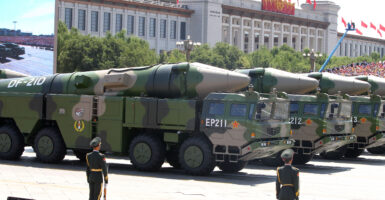The bad news from Beijing just keeps on coming.
In late June, the press reported that some researchers using commercial satellite imagery uncovered more than 100 new Chinese intercontinental ballistic missile silos being constructed in its northwestern desert.
And then in July, the news reported another shocking discovery by researchers again using commercial satellite imagery. This time, they found another 100 or so Chinese ICBM silos in a different new silo field a few hundred miles away.
In total, that’s more than 200-plus new Chinese ICBM silos.
It’s clear that when U.S. government officials have talked ambiguously about the People’s Republic of China doubling, tripling—or even quadrupling—its nuclear force in the next decade, that’s probably what they were referring to.
None of this is good news, but the bad news doesn’t end there.
China, once fielding only a modest nuclear force of land-based missiles, is evolving from being a nuclear “monad” into a nuclear “triad,” consisting of strategic land, sea, and air nuclear forces like those of the United States and Russia.
While Beijing is certainly no paragon of transparency, especially on security issues, it’s not completely unexpected.
China has been engaged in an unprecedented military buildup of its conventional forces for some time, and it has recently begun to pay significant attention to building out its strategic nuclear forces, too.
Indeed, in 2015, China established the People’s Liberation Army Rocket Force, which is responsible for China’s land-based conventional and nuclear missiles, as a separate service within the Chinese military—and on par with the army, navy, and air force.
It’s a big deal.
Moreover, as further evidence of the importance of the Rocket Force to China, according to the Pentagon, “In 2019, the [People’s Republic of China] launched more ballistic missiles for testing and training than the rest of the world combined.”
Plus, depending on how Beijing deploys those new silos—filling them all with missiles or filling some and leaving others as decoys to confuse an attacker, China could significantly increase the size of its land-based nuclear force.
The worry is that these new ICBMs may be armed with multiple, independently targetable, reentry vehicles, or MIRVs. That would mean that there could be five or more warheads, rather than one, on each ICBM.
This massive expansion should call into question the long-standing assessments that China will continue to have an estimated low-200 nuclear weapons in its stockpile.
Instead, these recent revelations suggest that Beijing could be in the throes of trying to reach nuclear near-parity—or even parity—with Washington in the coming years. (The U.S. has about 1,550 operational nuclear weapons.)
In addition, the People’s Liberation Army-Navy has also deployed several nuclear ballistic missile submarines, creating for the first time a mobile, stealthy at-sea strategic strike force for China’s leadership.
Those ballistic missile submarines will carry 12 submarine-launched ballistic missiles armed with nuclear warheads capable of reaching parts of the continental United States, depending on its firing location.
China is also modernizing its strategic bomber forces and arming them with nuclear-capable, air-launched ballistic missiles. Some analysts speculate that a nuclear-capable cruise missile for those bombers may also become available.
Lastly, a press report July 30 also exposed some construction work at a site used by China in the past for nuclear testing, possibly signaling another uptick in Beijing’s strategic activity levels.
It’s clear Beijing is emphasizing, diversifying, and expanding its nuclear forces.
A full-on nuclear triad of land, air, and sea legs will provide China’s nuclear deterrent with greater credibility, survivability, and flexibility than it had previously as a land-based silo and road-mobile force.
Those new capabilities will give Beijing greater freedom of action internationally to influence and coerce not only Washington, but also its Asian allies and partners. It will also limit the response options to China’s ongoing bad behavior and belligerence.
Beijing’s strategic force build-out will also insert more uncertainty—and risk—into an already challenging international security environment, now fraught with great- and major-power competition and rivalry.
As a result, the United States must carefully consider these developments, as well as craft responses to the growing Chinese nuclear threat, ensuring that U.S. national interests are protected and American nuclear deterrence remains indomitable.
Have an opinion about this article? To sound off, please email letters@DailySignal.com and we’ll consider publishing your edited remarks in our regular “We Hear You” feature. Remember to include the url or headline of the article plus your name and town and/or state.




























